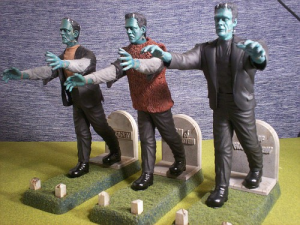
Plastic models of the Frankenstein monster, as he appeared in the 1931 Universal movie and later films
In the art deco-style movie theater downtown, I recently saw a filmed version of the National Theatre’s performance of “Frankenstein,” a dramatized version of the Shelley novel. It was directed by Danny Boyle, who also directed “Slumdog Millionaire” and “Trainspotting, and starred Benedict Cumberbatch and Jonny Lee Miller. In the filmed version, Cumberbatch played the monster (or the “creature,” if you prefer), and Miller played Victor Frankenstein — during the run of the play, they alternated the roles.
I saw the film with my English-major daughter, who had recently taken a class on “Frankenstein” and had a lot of good insights into the production. I had read the novel twice, once in high school (?) and once maybe 10 years ago, but it wasn’t very clear in my head. I recalled that reading it was a pretty tough slog.
But while I thought the National Theatre production was pretty faithful to the original novel, I also had the vague sense that it departed in several ways from the book. So I went back to read it again, and I’ve just finished it. I was right about one thing: It *is* a tough slog.
But I was glad I read it. Among other things, it made me realize how much the various film versions of “Frankenstein” have departed from the book, in large and small ways, and got me wondering whether the changes in the filmed version were improvements or not. In the novel, I noticed or re-noticed that:
— There is no explicit description of how the monster was brought to life, although the book contains some references to galvanism. That probably sparked, ha ha, all the arcing electrical current in several film versions.
— Everything in the novel is told by three male narrators: A ship’s captain, Robert Walton, who encounters Victor Frankenstein while on an expedition in the frozen North; Frankenstein; and the monster/creature himself. There’s no omniscient author/narrator who tells the story “as it happens” without the “framing device” of the three narrators.
— There’s no detailed description of the creature, although we gather that he’s (1) eight feet tall (?), (2) very strong and hardy, (3) has yellowish, translucent skin through which the muscles and tendons beneath virtually show; odd, perhaps dead-appearing eyes, “if eyes they may be called at all,” and flowing black hair.
— I was sure there was no “bride of Frankenstein” in the novel. And yet, in the book, in response to the monster’s request, Victor Frankenstein does work on creating a mate for the monster. But he never completes the work, and destroys her without ever bringing her to life.
Here’s a grab-bag of changes I noticed in the movie versions I’ve seen, and a few off-the-top-of-my-head comments:
— The James Whale version from the 1930s, the one starring Boris Karloff, totally eliminates the framing device of the three narrators. The make-up is terrific — the flat head, the stitches, the bolts in the neck, the heavy brow ridges, the pale skin. Karloff looks cadaverous and huge and scared the bejeebers out of me when I first saw the movie as a kid. Lots of it was invented for the movie, including the part about the little girl that the monster throws into the water. The blind hermit in the cabin in the woods was transmuted from a character in the book — a blind man who lived in a cottage with his two children.
— I saw an Andy Warhol version of “Frankenstein” as a college student, but all I remember is that it was very bloody and gross.
— A TV version with Michael Sarrazin (?) as the monster, which had the gall to bill itself in a subtitle as “The True Story,” made stuff up out of whole cloth. It had the monster himself killing his own “bride” and invented a character called “Dr. Polidori.” (There was a real Dr. Polidori — a British writer and Byron’s personal physician, and one of the people (with Mary Shelley) that Byron challenged to write a “ghost story.” That challenge, of course, led to Mary Shelley writing a tale that evolved into “Frankenstein.”)
— Most film versions I’ve seen have a “bride” for the monster. In most, she is brought to life and is repulsed by the monster — just like the rest of society that he encounters.
— The Kenneth Branagh version is faithful to the novel in several respects. It preserves the framing device of the ship’s captain/narrator. But it also includes a lot of inventions. For instance, it goes into a lot of scientific mumbo-jumbo about electricity and amniotic fluid; has Frankenstein surviving the monster’s immolation at the end, while in the original Frankenstein dies a natural death on the ice-bound ship while the monster simply *says* he plans to kill himself on a funeral pyre; and has a “bride” who’s brought to life but burns to death after encountering the monster.
— Likewise, the National Theatre production is pretty faithful, too. At least to the sense of the novel. But it creates a lot of dialogue and stages a lot of scenes that never occur in the book. For instance, the monster’s assault and murder of Elizabeth, Frankenstein’s wife, on their wedding night, is elaborate and drawn out in the play version. In the novel, it occurs “offstage,” with Frankenstein discovering her dead body after the monster has murdered her and then glimpsing the monster grinning evilly in the moonlight, through a window. The play also turns the blind man’s children into husband and wife, rather than siblings.
While I wish the film and play versions were more faithful to the original, I don’t argue with the changes. Movies and plays are different from books. You have to have your characters saying and doing something — not just have people *talking* about what those individuals have done.
